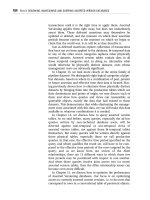Tài liệu QoS Control in 3G UMTS (final) docx
Bạn đang xem bản rút gọn của tài liệu. Xem và tải ngay bản đầy đủ của tài liệu tại đây (3.25 MB, 26 trang )
QoS Control in 3G UMTS
Group members:
1. Nguyễn Thạc Đức SHSV: 20090811
2. Nguyễn Văn Đức
3. Nguyễn Trung Đức
4. Trần Minh Đức
5. Phạm Thị Dung
CONTENTS
I. Overview of QoS in general
II. Requirements in UMTS
III.QoS structure in UMTS
IV.Control mechanisms
V. Conclusion
I. Overview of QoS
Quality of service (QoS) is the mechanism
insuring that a service can be delivered to
the end user in an acceptable time-frame and
the service properties are stable
I. Overview of QoS
QoS has three main characteristics as
below:
- Availability of the service
- Quality of information
- Consistent delivery
I. Overview of QoS
At a technical level, QoS is characterized
by:
- Service availability
- Delay
- Delay variation (jitter)
- Throughput
- Packet loss rate
II. Requirement in UMTS
The requirements for UMTS QoS are
devided into three categories:
- End user requirement
- General requirement
- Technical requirement
II. Requirement in UMTS
1. End user requirement for QoS
- Only the QoS perceived by end-user matter
- The number of user defined parameters has to be as
small as possible
- Definition of QoS attributes from the application
requirements has to be simple
- QoS attributes must be able to support all application
- QoS has to be provide end-to-end
III. Requirement in UMTS
2. General requirements for QoS
- QoS mechanism have to allow efficient use of radio
capacity
- Allow independent evolution of Core and Access
network
- QoS parameters should not be restricted to one or
few external QoS control mechanisms but the QoS
concept should be capable of providing different level of
QoS by using UMTS specific control mechanisms
II. Requirement in UMTS
3. Technical requirement for QoS
- The UMTS QoS mechanisms shall provide a mapping between
application requirements and UMTS services
- The UMTS QoS control mechanisms shall be able to efficiently
interwork with current QoS schemes
- QoS shall support efficient resource utilisation
- The QoS parameters are needed to support asymmetric bearers
- QoS behaviour should be dynamic , i.e., it shall be possible to
modify QoS parameters during an active session
III. QoS structure in UMTS
III. QoS structure in UMTS
1. QoS class
1.1. Conversational Class
•
The class supports real-time communication between
entities
•
Features:
- Preserve time relation (variation) between information
entities of the stream
- Conversational pattern (stringent and low delay)
•
Examples: Voice, videotelephon, video conferencing tools
III. QoS structure in UMTS
1.2. Streaming Class
•
The class intends to support applications
which are not real time but sensitive to jitter
•
Features: Preserve time relation between
information entities of the stream
•
Examples: Video downloading, news stream,
streaming video, webradio…
III. QoS structure in UMTS
1.3. Interactive class
•
The class supports non real-time services and
application
•
Features:
- Request response pattern
- Preserve payload content
•
Examples: Web browsing, interactive web,
database retrieval…
III. QoS structure in UMTS
1.4. Background class
•
The background class supports non real-time demands.
The class is served with the lowest priorities
•
Features:
- Destination is not expecting the data within a certain
time
- Preserve payload content
•
Examples: Background delivery of mails, files, SMS…
III. QoS structure in UMTS
2. UMTS QoS parameters/attributes
There are many QoS parameters/attributes defined for
UMTS:
•
Maximum bitrate
The maximum number of bits delivered by UMTS and to
UMTS within a period of time
•
Guaranteed bitrate
The guaranteed number of bits delivered by UMTS
within a period of time
III. QoS structure in UMTS
•
Delivery order (y/n)
To indicate whether the UMTS bearer shall
provide in-sequence SDU delivery or not
•
Maximum SDU (Service Data Unit)size (octets)
The maximum size of SDUs
•
SDU format information (bits)
A list of possible exact sizes of SDUs
III. QoS structure in UMTS
•
SDU error ratio
To indicate the fraction of SDUs lost or detected as
erroneous
•
Residual bit error ratio
To indicate the undetected bit error ratio in the
delivered SDUs
•
Delivery of erroneous SDUs (y/n/-)
To indicate whether SDUs detected as erroneous shall
be delivered or discarded or not
III. QoS structure in UMTS
•
Transfer delay (ms)
To indicate maximum delay for 95th percentile of
the distribution of delay for all delivered SDUs
during the lifetime of a bearer service
•
Traffic handling priority
To specify the relative importance for handling of
all SDUs belonging to the UMTS bearer compared
to the SDUs of other bearers
III. QoS structure in UMTS
•
Allocation/Retention Priority
To specify the relative importance compared to other
UMTS bearers for allocation and retention of the UMTS
bearer
•
Source statistics descriptor (‘speech’/’unknown’)
To specify characteristics of the source of submitted
SDUs
•
Signaling Indication (Yes/No)
To indicate the signaling nature of the submitted SDUs
IV. Control mechanisms
IV. Control mechanisms
Translation functions (Trans.)
Convert between external service signalling and
internal service primitives including the translation
of the service attributes.
IV. Control mechanisms
UMTS BS manager
- Signal between each other and via the
translation function with external instances to
establish or modify a UMTS bearer service.
- Interrogates its associated admission/capability
control whether the network entity supports the
specific requested service and whether the required
resources are available.
IV. Control mechanisms
The RAB manager
- Verifies with its admission/capability control whether
the RAN supports the specific requested service and
whether the required resources are available.
- Translates the RAB service attributes into radio bearer
service and RAN Access bearer service attributes and
requests the radio BS manager and the RAN Access BS
manager to provide bearer services with the required
attributes.
IV. Control mechanisms
Radio, RAN Access and CN BS
Managers use services provided by lower layers.
V. Conclusion
•
3G provides benefits to both the end users and
service providers with advantages of both
technologies
•
However, many challenge issues still exist for the
integrated network
•
QoS guarantee in integrated 3G networks deserves
further investigations









